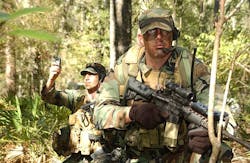SOCOM last week issued a broad agency announcement (H92222-14-BAA-SORDAC-SRSE) for Special Reconnaissance, Surveillance, & Exploitation (SRSE) technologies. The solicitation was released on behalf of the SOCOM Special Operations Research, Development, And Acquisition Center (SORDAC) Intelligence & Information Division.
Awards will be considered for research and development experiments and tests, feasibility studies, technology evaluations, integrated technology evaluations, prototypes, operability, modeling, computational analysis, engineering and manufacturing development, and simulations, SOCOM officials say. This BAA will remain open through the end of 2015.
The SOCOM SRSE focuses on eight product areas: tags; sensors; biometrics; forensics; signals intelligence (SIGINT); processing, exploitation, and dissemination (PED); Tactical Exploitation of National Capabilities (TENCAP); and technical support systems (TSS).
Related: Special Operations Command looking for next-gen underwater navigation instruments
Tags cover tagging, tracking and locating (TTL) technologies that can be used on persons and objects. Technologies of interest would provide reductions in size, weight and power and price (SWaP2) and improved accuracy.
SOCOM officials are interested in new tags capabilities involving GPS data loggers for both normal and disadvantaged environments; GPS tags for normal and disadvantaged environments; non-GPS trackers; optical taggants; chemical taggants; audio recorders; video recorders; RF tags; RF beacons; optical beacons; viewers for optical beacons and taggants; data infiltration and exfiltration devices and architectures; and enhancements in power devices.
Sensors cover persistent surveillance systems such as unattended ground sensor (UGS) systems, tactical surveillance systems, and force protection systems.
Related: General Dynamics wins SOCOM competition to build Ground Mobility Vehicle GMV 1.1
SOCOM researchers are interested in magnetic, seismic, passive infrared, acoustic, fiber optic and breakwire activity sensors; active sensors such as small radars and laser trip sensors; controller devices, hubs, and master nodes; day and night imaging devices, still and video; on camera video motion detection; image and video compression techniques; and improved sensor algorithms to reduce false alarms and missed detections.
Researchers also are interested in sensor algorithms for fusing data from several sensors to reduce false alarms; sensor algorithms for location, classification, and identification of targets; data infiltration and exfiltration devices and architectures; sensor network devices; “through the wall” sensing capabilities; and enhancements in the ability to power sensors and communications either through better power sources or improved efficiencies.
Biometrics covers small technologies to identify personnel in two minutes or less. Researchers would like to reduce false alarm rates, and operate at short and long distances in all environmental conditions.
Related: Project moves ahead to develop mini-submarines for covert special operations forces
Technologies of interest are facial recognition; iris recognition; finger print collection; detection and analysis of behavior patterns; voice print analysis; dynamic signature recognition; and DNA collection and processing.
Forensics covers collecting and processing of physical and electronic information obtained from target locations. The technologies should improve software applications, sensitivity, identification, processing speed, and data correlation.
Technologies of interest are document exploitation; electronic media exploitation; computers; cell phones; trace evidence collection, identification, and processing; explosives and chemicals; biological and radiological; and with the ability to detect hidden rooms and chambers.
Related: Wanted: special-ops battle suit with cooling, embedded computers, radios, and sensors
SIGINT technologies concentrate on RF communications intercept and location. Technologies of interest should provide improved performance, flexibility, SWaP2, and lower cost of ownership. Platforms and operational environments can be on land, air, sea, manned or unmanned, and manpack based.
Technologies of interest are software defined radios; readily reprogrammable and reconfigurable RF sensing receivers; data infiltration and exfiltration for payload information transport; security features for unattended operation; analog and digital receivers; improved sensitivity and efficiency; data infiltration and exfiltration for payload information transport; and security features for unattended operation.
Also of interest are advanced antennas for active and passive RF receive and transmit; conformal and antenna arrays; man packable and mobile antennas; small antennas; simplified integration; multiband and concealed applications; and meta-material solutions.
Processing, exploitation and dissemination (PED) covers items used to process and analyze intelligence data for display and generation of intelligence.
Technologies of interest are all source data discovery; advanced algorithms for data fusion and analysis; tasking and synchronization; receipt and processing of several intelligence ISR sensor data; cross domain; disconnected operations; open service oriented architecture; and common interactive broadcast (CIB) technologies.
Tactical exploitation of national capabilities (TENCAP) concentrates on technologies, processing and capabilities to extend national technical means investments and capabilities to the lowest tactical echelon user possible.
Related: General Atomics to provide lithium ion batteries for special operations mini-submarines
Technologies of interest are data infiltration and exfiltration; Geo-spatial intelligence (GEOINT); interpretation and analysis tools that expedite processing, improve performance and flexibility; imaging products; and integrated products from platforms, to include land, air, space, sea, manned or unmanned, and manpack based.
Technical support systems (TSS) concentrates on items critical to mission success but that often are not part of the initial design. Technologies of interest should provide improved performance, SWaP2 and ease of use.
Technologies of interest are virtual training; technologies to format virtual training classes that adapt to the individual’s knowledge level; power sources; primary batteries; rechargeable batteries; solar; fuel cell; energy harvesting; hybrid systems.
Also of interest are camouflage and concealment materials; adhesives; and conformal; physically small; tunable; multi-band; broadband; high gain; steerable; efficient antenna designs. high efficiency electronics; amplifiers and transmitters; controllers; imagers; and displays also are of interest.
Companies interested should submit proposals no later than 31 Dec. 2015 online at www.socom.mil/sordac/Pages/SRSEBAASubmission.
For questions or concerns email SOCOM's Rick Baumgartner at [email protected], or Erica Fairley at [email protected].
More information is online at https://www.fbo.gov/spg/ODA/USSOCOM/SOAL-KB/H92222-14-BAA-SORDAC-SRSE/listing.html. Details in .pdf form are online at https://www.fbo.gov/utils/view?id=b3c179abb35aaef70a9e8b4ac0ac38a5.



